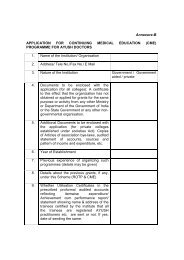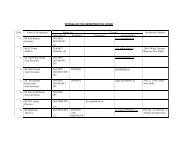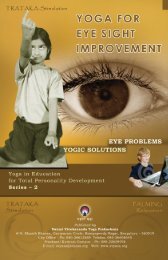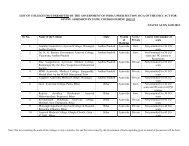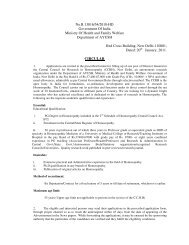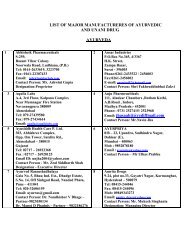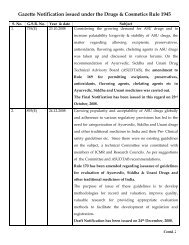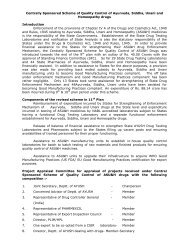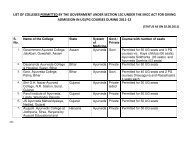Background - Department of AYUSH
Background - Department of AYUSH
Background - Department of AYUSH
You also want an ePaper? Increase the reach of your titles
YUMPU automatically turns print PDFs into web optimized ePapers that Google loves.
AN OVERVIEW OFTHE DEPARTMENT OF <strong>AYUSH</strong><strong>Background</strong><strong>Department</strong> <strong>of</strong> Indian Systems <strong>of</strong> Medicine and Homoeopathy (ISM&H) was created in March,1995 and re-named as<strong>Department</strong> <strong>of</strong> Ayurveda, Yoga & Naturopathy, Unani, Siddha and Homoeopathy (<strong>AYUSH</strong>) in November, 2003 with a view toproviding focused attention to development <strong>of</strong> Education & Research in Ayurveda, Yoga & Naturopathy, Unani, Siddha andHomoeopathy systems. The <strong>Department</strong> continued to lay emphasis on upgradation <strong>of</strong> <strong>AYUSH</strong> educational standards, qualitycontrol and standardization <strong>of</strong> drugs, improving the availability <strong>of</strong> medicinal plant material, research and development andawareness generation about the efficacy <strong>of</strong> the systems domestically and internationally.OBJECTIVES:To upgrade the educational standards in the Indian Systems <strong>of</strong> Medicines and Homoeopathy colleges in the country.• To strengthen existing research institutions and ensure a time-bound research programme on identified diseases forwhich these systems have an effective treatment.• To draw up schemes for promotion, cultivation and regeneration <strong>of</strong> medicinal plants used in these systems.• To evolve Pharmacopoeial standards for Indian Systems <strong>of</strong> Medicine and Homoeopathy drugs.<strong>Department</strong> <strong>of</strong> Indian Systems <strong>of</strong> Medicine and Homoeopathy (ISM&H) was created in March,1995 and re-named as<strong>Department</strong> <strong>of</strong> Ayurveda, Yoga & Naturopathy, Unani, Siddha and Homoeopathy (<strong>AYUSH</strong>) in November, 2003 with a view toproviding focused attention to development <strong>of</strong> Education & Research in Ayurveda, Yoga & Naturopathy, Unani, Siddha andHomoeopathy systems. The <strong>Department</strong> continued to lay emphasis on upgradation <strong>of</strong> <strong>AYUSH</strong> educational standards, qualitycontrol and standardization <strong>of</strong> drugs, improving the availability <strong>of</strong> medicinal plant material, research and development andawareness generation about the efficacy <strong>of</strong> the systems domestically and internationally.
OBJECTIVES:• To upgrade the educational standards in the Indian Systems <strong>of</strong> Medicines and Homoeopathy colleges in the country.• To strengthen existing research institutions and ensure a time-bound research programme on identified diseases forwhich these systems have an effective treatment.• To draw up schemes for promotion, cultivation and regeneration <strong>of</strong> medicinal plants used in these systems.• To evolve Pharmacopoeial standards for Indian Systems <strong>of</strong> Medicine and Homoeopathy drugs.SOBORDINATE OFFICESPharmacopoeia Laboratory <strong>of</strong> Indian Medicine (PLIM)Homoeopathic Pharmacopoeia Laboratory (HPL)RESEARCH COUNCILSCentral Council for Research in Ayurveda (CCRAS)Central Council for Research in Siddha(CCRS)Central Council for Research in Unani Medicine (CCRUM)Central Council for Research in Homoeopathy (CCRH)Central Council for Research in Yoga & Naturopathy (CCRYN)EDUCATIONAL INSTITUTESNational Institute <strong>of</strong> Ayurveda, Jaipur (NIA)National Institute <strong>of</strong> Siddha, Chennai (NIS)National Institute <strong>of</strong> Homoeopathy, Kolkata (NIH)National Institute <strong>of</strong> Naturopathy, Pune (NIN)National Institute <strong>of</strong> Unani Medicine, Bangalore (NIUM)Institute <strong>of</strong> Post Graduate Teaching and Research in Ayurveda,Rashtriya Ayurveda Vidyapeeth, New Delhi (RAV)Morarji Desai National Institute <strong>of</strong> Yoga, New Delhi (MDNIY)STATUTORY COUNCILSCentral Council for Indian Medicine (CCIM)
Central Council for Homoeopathy (CCH)NATIONAL MEDICINAL PLANTS BOARD (NMPB)PUBLIC SECTOR UNDERTAKING (PSU)Indian Medicine Pharmacutical Corporation Limited (IMPCL), Mohan,UttaranchalRESEARCH COUNCILSThere are five Research Councils, viz.,Central Council for Research in Ayurveda & Siddha (CCRAS)Central Council for Research in Siddha(CCRS)Central Council for Research in Unani Medicine (CCRUM);Central Council for Research in Homoeopathy (CCRH); andCentral Council for Research in Yoga & Naturopathy (CCRYN),RESEARCH AND DEVELOPMENT ACTIVITYThese Councils initiate and guide, develop and coordinate scientific research in different aspects <strong>of</strong> respective systems,both fundamental and allied. These Councils are the Apex bodies for research in the concerned systems <strong>of</strong> medicine and arefully financed by theGovt. <strong>of</strong> India.CENTRAL COUNCIL FOR RESEARCH IN AYURVEDA AND SIDDHA (CCRAS)1. PARTICULARS OF THE ORGANIZATION, FUNCTIONS AND DUTIESCentral Council for Research in Ayurveda & Siddha (CCRAS) is an apex body in India for undertaking, coordinating, aiding andpromoting research in Ayurveda and Siddha. The Council was established in March 1978 after bifurcation <strong>of</strong> the erstwhile CentralCouncil for Research in Indian Medicine and Homoeopathy (CCRIM&H). The Council carries out its activities through the network<strong>of</strong> research Institutes and Centres functioning under its direct control and through a number <strong>of</strong> Units located inUniversities/Institutes/Hospitals in different parts <strong>of</strong> the country. Research activities <strong>of</strong> the Council include Clinical Research, Drug
Research, Literary Research, Bio-medical Instrumentation <strong>of</strong> Panchakarma etc. At present 30 research Institutes/Centres/Units arefunctioning. Their address list and activities are annexed.The Council has also undertaken collaborative research work with many premier Institutions2. MISSION AND VISIONThe Mission• To undertake scientific research in Ayurveda in a time bound and cost-effective manner.• To coordinate, aid, promote and collaborate research with different units <strong>of</strong> CCRAS and other sister Councils/Organizations.• To publish and exhibit research achievements/articles/research journals to propagate research outcomes for other stakeholders.• To provide consultancy services for research projects/drug development.• To modernize equipments used in Ayurveda / therapy and drug manufacturing in collaboration with other technicalorganizations.3. THE VISIONIn due appreciation <strong>of</strong> emerging health scenario and requirement <strong>of</strong> Ayurveda, CCRAS enunciates following vision statements:• To develop CCRAS into a dynamic vibrant and model research organization for undertaking, coordinating, aiding andpromoting research on Ayurveda.• To focus research on the needs <strong>of</strong> India with a view to emerging health requirement <strong>of</strong> the country.• To attain global leadership in research for treatment and prevention <strong>of</strong> emerging important life style related diseases and healthrequirement.• To create awareness and to promote competitiveness, excellence and innovation among the researchers in the field <strong>of</strong>Ayurveda.• To bring up modern scientific knowledge, technology to explore Ayurveda scientific treasure following prevalent scientificmethods.4. COMMITMENTS
• The Council will focus research on important diseases to find out feasible solutions through Ayurveda Systems <strong>of</strong> Medicine.• We will promote Ayurveda in India and abroad.• The Council will remain dutiful, disciplined and efficient.• We will treat all stakeholders with respect and due courtesy.• We will promptly attain enquiries related to Ayurveda research.• We will provide proper treatment facilities to patients coming to our OPD & IPD.5. OBJECTIVES• To carry out clinical research on prioritized disease conditions both as Intramural and collaborative• To carry out survey <strong>of</strong> medicinal plants, pharmacognostical work and study on propagation techniques• To establish methods <strong>of</strong> analysis for standardization and quality control <strong>of</strong> single drugs and compound formulations• To conduct experimental studies for efficacy <strong>of</strong> the drugs/formulations and to establish their safety/toxicity pr<strong>of</strong>ile• To conduct study on tribal health and collection <strong>of</strong> folklore claims• Retrieval and revival <strong>of</strong> Ayurvedic texts from ancient manuscripts and publication <strong>of</strong> journals, monographs, books, technicalreports etc.• Timely compliance to financial accountabilityCENTRAL COUNCIL FOR RESEARCH IN SIDDHAPARTICULARS OF THE ORGANIZATION, FUNCTIONS AND DUTIESCentral Council for Research in Siddha (CCRS) is an apex body in India for undertaking, coordinating, aiding andpromoting research in Siddha. The Council has been bifurcated from CCRS and functioning independently w.e.f 1 st Sep.2011 consequent upon the decision <strong>of</strong> the Cabinet in its meeting dated 04 th March, 2010 and the organization has beenregistered under the Tamil Nadu Societies Registration Act. 1975 on 27 th July, 2010. The Council carries out its activitiesthrough the network <strong>of</strong> research Institutes and Centres functioning under its direct control and through a number <strong>of</strong> Unitslocated in TamilNadu, Puducherry and Kerala. Research activities <strong>of</strong> the Council include Clinical Research, DrugResearch, Literary Research etc. At present 5 research Institutes/Centres/Units are functioning.
MISSION AND VISIONThe Mission• To undertake scientific research in Siddha in a time bound and cost-effective manner.• To coordinate, aid, promote and collaborate research with different units <strong>of</strong> CCRS and other sisterCouncils/Organizations.• To publish and exhibit research achievements/articles/research journals to propagate research outcomes for otherstakeholders.• To provide consultancy services for research projects/drug development.• To modernize equipments used in Siddha / therapy and drug manufacturing in collaboration with other technicalorganizations.The VisionIn due appreciation <strong>of</strong> emerging health scenario and requirement <strong>of</strong> Siddha, CCRS enunciates following visionstatements:• To develop CCRS into a dynamic vibrant and model research organization for undertaking, coordinating, aidingand promoting research on Siddha.• To focus research on the needs <strong>of</strong> India with a view to emerging health requirement <strong>of</strong> the country.• To attain global leadership in research for treatment and prevention <strong>of</strong> emerging important life style relateddiseases and health requirement.• To create awareness and to promote competitiveness, excellence and innovation among the researchers in thefield <strong>of</strong> Siddha.• To bring up modern scientific knowledge, technology to explore Siddha scientific treasure following prevalentscientific methods.COMMITMENTS• The Council will focus research on important diseases to find out feasible solutions through Siddha Systems <strong>of</strong>Medicine.• We will promote Siddha in India and abroad.
• The Council will remain dutiful, disciplined and efficient.• We will treat all stakeholders with respect and due courtesy.• We will promptly attain enquiries related to Siddha research.• We will provide proper treatment facilities to patients coming to our OPD & IPD.OBJECTIVES• To carry out clinical research on prioritized disease conditions both as Intramural and collaborative• To carry out survey <strong>of</strong> medicinal plants, pharmacognostical work and study on propagation techniques• To establish methods <strong>of</strong> analysis for standardization and quality control <strong>of</strong> single drugs and compound formulations• To conduct experimental studies for efficacy <strong>of</strong> the drugs/formulations and to establish their safety/toxicity pr<strong>of</strong>ile• To conduct study on tribal health and collection <strong>of</strong> folklore claims• Retrieval and revival <strong>of</strong> Siddha texts from ancient manuscripts and publication <strong>of</strong> journals, monographs, books,technical reports etc.• Timely compliance to financial accountabilityACTIVITIES AND ACHIEVEMENTSThe research Programme under this Council may be broadly categorized into Clinical Research (including Health Care Research),Drug Research (including Medico-Ethno-Botanical Survey and Cultivation <strong>of</strong> Medicinal Plants, Pharmacognosy, DrugStandardization), Pharmacological/Toxicological studies, Reproductive and Child Health Care Research, Literary Research alongwith Documentation and Publication.SERVICES/FACILITIES AVAILABLE• Patient consultancy services: The Council provides free treatment, investigation facilities and medicines to the researchpatients in OPD and IPDs through its various Institutes. It also provides consultation, investigations and medicines on nominalcharges to the general patients .
• Specialized Therapy Services: The Council is providing free Varma treatment to the patients <strong>of</strong> Research Projects and onnominal charges to general patients.• Research Consultancy Services: The Council is providing consultancy services on various areas like Clinical Research,Drug Research etc. to other organizations, individuals and industries.• Library Services: The Council is maintaining Libraries at various Institutes.• Publications and Sales: There is a special division for publication and sale <strong>of</strong> Council’s research outcomes.• Financial Assistance: The Council is coordinating execution <strong>of</strong> Extra Mural Research Projects <strong>of</strong> <strong>Department</strong> <strong>of</strong> <strong>AYUSH</strong> toeligible organizations for the research and developmentCENTRAL COUNCIL FOR RESEARCH IN UNANI MEDICINEThe Central Council for Research in Unani Medicine (CCRUM) was established on 30 March 1978 as an autonomousorganization <strong>of</strong> Ministry <strong>of</strong> Health and Family Welfare, Government <strong>of</strong> India. The Council, however, started workingindependently since 10 January 1979.MAIN OBJECTIVES• Formulation <strong>of</strong> aims and patterns <strong>of</strong> research on scientific lines in Unani Medicine.• To undertake research or other programmes in Unani Medicine.• Prosecution <strong>of</strong> and assistance in research, and propagation <strong>of</strong> knowledge and experimental measures generally inconnection with the causation, mode <strong>of</strong> spread and prevention <strong>of</strong> diseases.• To initiate, aid, conduct, develop and co-ordinate scientific research in different aspects, fundamental and applied, <strong>of</strong>Unani Medicine and to promote and assist institutions <strong>of</strong> research for the study <strong>of</strong> diseases, their prevention causation andremedy.
• To finance enquiries and researches for the furtherance <strong>of</strong> objectives <strong>of</strong> the Council.• To exchange information with other institutions, associations and societies interested in the objectives similar to those <strong>of</strong>the Council and specially in observation and study <strong>of</strong> diseases in the East in general and in India in particular.• To prepare, print, publish and exhibit papers, posters, pamphlets, periodicals and books to achieve the objectives <strong>of</strong> theCouncil and to contribute to such literature.RESEARCH PROGRAMMESCLINICAL RESEARCH• Conduct studies on etio-pathogenesis <strong>of</strong> different diseases from Unani point <strong>of</strong> view.• Conduct clinical studies/therapeutic trials <strong>of</strong> single and compound drugs in different diseases.• Scientific validation and development <strong>of</strong> Standard Operating Procedures (SOPs) for Unani regimen therapies.• Clinico-pharmacological studies and safety evaluation <strong>of</strong> Unani single drugs & compound formulations.• Scientific validation <strong>of</strong> fundamentals <strong>of</strong> Unani Medicine.• Research Oriented Medicare-cum-clinical research programme.• Extension health services.DRUG RESEARCH• Standardization <strong>of</strong> single drugs and compound formulations• Standardization <strong>of</strong> method <strong>of</strong> manufacturing <strong>of</strong> finished products• Development <strong>of</strong> Standard Operating Procedures for compound drugs• Chemical investigations on Unani drugs <strong>of</strong> plant, mineral and animal origin.SURVEY & CULTIVATION OF MEDICINAL PLANTS• Ethnobotanical exploration <strong>of</strong> forest areas.• Collection <strong>of</strong> medicinal folk claims from different tribes and their documentation.• Experimental and large scale cultivation <strong>of</strong> important medicinal plants.
• Development <strong>of</strong> agro-techniques for cultivation <strong>of</strong> Unani medicinal plants and transfer <strong>of</strong> technology to the farmers.LITERARY RESEARCH• Collation, editing and translation <strong>of</strong> important classical Unani manuscripts/ books in different languages• Compilation <strong>of</strong> books/booklets on Unani Medicine on different aspects including therapeutics,• Compilation <strong>of</strong> standard treatment guidelines on difference diseases from Unani point <strong>of</strong> view.• Development <strong>of</strong> database on Unani MedicineIEC ACTIVITIES• Production <strong>of</strong> Information Education & Communication (IEC) material in different languages for the masses.• Production <strong>of</strong> documentaries, spots, short films on different diseases highlighting the therapeutic effects <strong>of</strong> Unanimedicine in prevention, promotion and cure <strong>of</strong> diseases.• Organization <strong>of</strong> Seminars/Workshops/Health exhibitions/Health camps/ Health Melas to disseminate the researchfindings and propagate the system among the masses.• Collaboration with the international organization for development <strong>of</strong> Unani medicine in foreign countriesThe above research activities are being carried through a network <strong>of</strong> 22 centers in different parts <strong>of</strong> the country whichinclude the following:CCRUM Headquarters New Delhi• Central Research Institutes <strong>of</strong> 02 • Hyderabad (Andhra Pradesh)Unani Medicine • Lucknow (Uttar Pradesh)• Regional Research Institutes <strong>of</strong> 08 • New Delhi (with two UnaniMedical extension centersUnani Medicine • Chennai (Tamil Nadu)• Bhadrak (Orissa)• Patna (Bihar)
• Aligarh (Uttar Pradesh)• Mumbai (Maharashtra)• Srinagar (Jammu & Kashmir)• Regional Research Centre (Unani) 02 • Allahabad (Uttar Pradesh)• Silchar (Assam) withextension centre at Karimganj• Clinical Research Units (Unani) 05 • Bangalore (Karnataka)• Bhopal (Madhya Pradesh)• Edathala (Kerala)• Meerut (Uttar Pradesh)• Burhanpur (Madhya Pradesh)• Clinical Research Pilot Project (Unani) 01 • Lachua (Manipur)•Drug Standardization Research Institute 01• Ghaziabad (Uttar Pradesh)• Drug Standardization Research Units 01 • New Delhi• Chemical Research Units(Grant-in-aid) 01 • Aligarh (Uttar Pradesh)• Literary Research Institute 01 • New Delhi
CENTRAL COUNCIL FOR RESEARCH IN HOMOEOPATHY (CCRH)INTRODUCTIONTo streamline research in Homoeopathy, a need <strong>of</strong> planned and organized research was strongly felt by the Government <strong>of</strong>India. As a result, the Central Council for Research in Indian Medicine and Homoeopathy (CCRIMH) was established in 1969 tocarry out researches in Ayurveda, Siddha, Unani medicine, Yoga and Homoeopathy. The Central Council for Research inHomoeopathy (CCRH), one <strong>of</strong> the successor organizations to the erstwhile CCRIMH was established as an autonomousorganization, at New Delhi in 1978. Ever since, CCRH remains a unique organization engaged in various research studies inHomoeopathy .GROWTH AND DEVELOPMENTOver the years, CCRH had branched into 51 subordinate Institutes and Units functioning in different parts <strong>of</strong> the country. Toimprove the functioning <strong>of</strong> the research centers further and to ensure quality research, the Dept. <strong>of</strong> <strong>AYUSH</strong> has decided toconsolidate the centers further, by merging the smaller units, in two phases, i.e. to consolidate to 24 centers in Phase - I and to19 centers in Phase-II. In Phase -I, a number <strong>of</strong> Units have been merged with other Institutes or Units making it a total <strong>of</strong> 27Institutes / Units at present as given below:• Central Research Institute - 02• Homoeopathic Drug Research Institute - 01• Regional Research Institute - 07• Clinical Research Unit - 11• Clinical Verification Unit - 01• Drug Proving Research Unit - 01• Drug Standardization Unit - 01• Survey <strong>of</strong> Medicinal Plants and cultivation Unit - 01• Drug Standardization Units ( Extension) - 02These Institutes and Units are carrying out researches in various aspects <strong>of</strong> Homoeopathy viz.i. Survey, collection and Cultivation <strong>of</strong> Medicinal Plants
ii. Drug Standardization studiesiii. Drug Proving Researchiv. Clinical Verification studiesv. Clinical ResearchAIMS AND OBJECTIVES• To formulate aims and patterns <strong>of</strong> research on scientific lines in Homoeopathy.• To initiate, develop, undertake and co-ordinate scientific research in fundamental and applied aspects <strong>of</strong> Homoeopathy.• To collaborate research studies with other institutes <strong>of</strong> excellence towards promotion <strong>of</strong> Homoeopathy.• To exchange information with other institutions, associations and societies interested in the objects similar to those <strong>of</strong>the Central Council and especially in observation and study <strong>of</strong> diseases.• To propagate research findings through monographs, journals/workshops & develop audiovisual aids for dissemination <strong>of</strong>information to the pr<strong>of</strong>ession & public.The main objectives <strong>of</strong> the Council are:-1. The formulation <strong>of</strong> aims and patterns <strong>of</strong> research on scientific lines in Homoeopathy.2. To undertake any research or other programmes in Homoeopathy.3. The prosecution <strong>of</strong> and assistance in research , the propagation <strong>of</strong> knowledge and experimental measures generally inconnection with the causation, mode <strong>of</strong> spread and prevention <strong>of</strong> diseases.4. To initiate, develop, coordinate scientific research in different aspects, fundamental and applied <strong>of</strong> Homoeopathy and topromote and assist institutions <strong>of</strong> research for the study <strong>of</strong> diseases, their prevention, causation and remedy.5. To finance enquiries and researches for the furtherance <strong>of</strong> objects <strong>of</strong> the Central Council.6. To exchange information with other institutions, associations and societies interested in the objects similar to those <strong>of</strong> theCentral Council and specially in observation and study <strong>of</strong> diseases in East and in India in particular.7. To prepare, print, publish and exhibit any papers, posters, pamphlets, periodicals and books for furtherance <strong>of</strong> the objects <strong>of</strong>the Central Council and contribute to such literature8. To issue appeals and make applications for money and funds in furtherance <strong>of</strong> the objects <strong>of</strong> the Central Council and to acceptfor the aforesaid purpose gifts, donations and subscriptions <strong>of</strong> cash and securities and <strong>of</strong> any property whether movable orimmovable.9. To borrow or raise monies with or without security or on security mortgage, charge, hypothecation or pledge <strong>of</strong> all or any <strong>of</strong>the immovable or movable properties belonging to the Central Council or in any other manner whatever.
10. To invest and deal with the funds and monies <strong>of</strong> the Central Council or entrusted to the Central Council not immediatelyrequired in such manner as may from time to time be determined by the Governing body <strong>of</strong> the Central Council.11. To permit the funds <strong>of</strong> the Central Council to be held by the Government <strong>of</strong> India.12. To acquire and hold, whether temporarily or permanently any movable or immovable property necessary or convenient for thepurpose <strong>of</strong> the Central Council.13. To sell, lease mortgage and exchange and otherwise transfer any <strong>of</strong> the properties movable or immovable <strong>of</strong> the CentralCouncil provided prior approval <strong>of</strong> the Central government is obtained for the transfer <strong>of</strong> the immovable property.14. To purchase, construct, maintain and alter any buildings or works necessary or convenient for the purpose <strong>of</strong> the CentralCouncil.15. To undertake and accept the management <strong>of</strong> any endowment or trust fund for donation the undertaking or acceptance where<strong>of</strong>may seem desirable.16. To <strong>of</strong>fer prizes and grant <strong>of</strong> scholarships, including traveling scholarships in furtherance <strong>of</strong> the objects <strong>of</strong> the Central Council.17. To create administrative, technical and ministerial and other posts under the society and to make appointments there to inaccordance with rules and regulations <strong>of</strong> the Society.18. To establish a provident fund and or pension fund for the benefit <strong>of</strong> the Central Council’s employees and/or their familymembers19. To do all such other lawful things either alone or in conjunction with others as the Central Council may consider necessary oras being incidental or conducive to the attainment <strong>of</strong> the above objects.Organizational set up :At present, the Council has 24 Institutes/ Units as stated below:• Central Research Institute - 02• Homoeopathic Drug Research Institute - 01• Regional Research Institute - 07• Clinical Research Unit - 10• Drug Proving Research Unit - 01• Drug Standardization Unit - 01• Survey <strong>of</strong> Medicinal Plants and cultivation Unit - 01• Homoeopathic Treatment Center – 01Research Activities
i. Clinical Researchii. Drug Proving Researchiii. Clinical Verificationiv. Drug Standardizationv. Survey, Collection and Cultivation <strong>of</strong> Medicinal Plantsvi. Collaborative Researchvii. Extra Mural Researchviii. PublicationsYOGA & NATUROPATHYThe Govt. <strong>of</strong> India after having recognized the need for systematic Research and Development <strong>of</strong> Ayurveda, Yoga & Naturopathy, Unani,Siddha and Homeopathy in the country, established the Central Council for Research in Indian Medicine & Homoeopathy (CCRIMH) in 1969as an autonomous organization under the Ministry <strong>of</strong> Health & F.W.. This organization, first <strong>of</strong> its kind was established in India by the CentralGovt. to conduct Scientific Research in Ayurveda, Siddha, Unani and Yoga, existed upto 1978. During this period, the development <strong>of</strong>Naturopathy was looked after by the Ministry <strong>of</strong> Health & Family Welfare directly. Later, in March 1978, this composite Council wasdissolved to pave way for the formation <strong>of</strong> four independent Research Councils, one each for Ayurveda and Siddha, Unani, Homeopathy andYoga & Naturopathy.Hence, Central Council for research in Yoga and Naturopathy was established in 1978 with a view to provide better opportunities for allrounddevelopment <strong>of</strong> Yoga and Naturopathy independently according to their own doctrines and fundamental principles.The activities <strong>of</strong> the Council are governed by two Committees:• Governing Body• Standing Finance CommitteeSOWA – RIGPA
“Sowa-Rigpa” commonly known as Amchi system <strong>of</strong> medicine is one <strong>of</strong> the oldest, Living and well documented medicaltradition <strong>of</strong> the world. It has been popularly practice in Tibet, Magnolia, Bhutan, some parts <strong>of</strong> China, Nepal, Himalayan regions<strong>of</strong> India and few parts <strong>of</strong> former Soviet Union etc. There are various schools <strong>of</strong> thought about the origin <strong>of</strong> this medicaltradition, some scholars believes that it is originated from India, some says China and others consider it to be originated fromTibet itself. The majority <strong>of</strong> theory and practice <strong>of</strong> Sowa-Rigpa is similar to “Ayurveda” . The first Ayurvedic influence came toTibet during 3 rd century AD but it became popular only after 7 th centuries with the approach <strong>of</strong> Buddhism to Tibet. There afterthis trend <strong>of</strong> exportation <strong>of</strong> Indian medical literature, along with Buddhism and other Indian art and sciences were continued tillearly 19 th century. India being the birth place <strong>of</strong> Buddha and Buddhism has always been favorite place for learning Buddhist artand culture for Tibetan students; lots <strong>of</strong> Indian scholars were also invited to Tibet for prorogation <strong>of</strong> Buddhism and other Indianart and sciences. This long association with India had resulted in translation and preservation <strong>of</strong> thousands <strong>of</strong> Indian literatureon various subjects like religion, sciences, arts, culture and language etc. in Tibetan language. Out <strong>of</strong> these around twenty-fivetext related to medicine are also preserved in both canonical and non-canonical forms <strong>of</strong> Tibetan literatures. Many <strong>of</strong> theseknowledge were further enriched in Tibet with the knowledge and skills <strong>of</strong> neighboring countries and their own ethnicknowledge. “Sowa-Rigpa” (Science <strong>of</strong> healing) is one <strong>of</strong> the classic examples <strong>of</strong> it. Gyud-Zi (four tantra) the fundamental textbook <strong>of</strong> this medicine was first translated from India and enriched in Tibet with its own folklore and other medical tradition likeChinese and Persian etc. The impact <strong>of</strong> Sowa-Rigpa along with Buddhism and other Tibetan art and sciences were spread inneighboring Himalayan regions. In India this system has been practiced in Sikkim, Arunachal Pardesh, Dargeling (West Bangal),Lahoul & Spiti (Himanchal Pardesh) and Ladakh region <strong>of</strong> Jammu& Kashmir etc.IMMEDIATE CONCERNS OF THE DEPTT.• φ Golden Triangle partnership scheme with CSIR, ICMR and Drug Manufacturers.• φ National Ayurveda Institute, Sarita Vihar.• φ North-Eastern Regional Institute.• φ Upgradation <strong>of</strong> Councils and Institutes in terms <strong>of</strong> infrastructure.
• φ Reorientation <strong>of</strong> Research.• φ Standardization <strong>of</strong> drugs.ACTIVITIES• The department is undertaking multi-pronged, integrated and comprehensive set <strong>of</strong>• activities for promoting quality education, state-<strong>of</strong>-art research, standardization <strong>of</strong> drugs, quality assurance, providingquality raw material, integration <strong>of</strong> <strong>AYUSH</strong> and National Health• Care Programmes and Delivery Systems; establishing Traditional Knowledge Digital Library (TKDL) etc. Further, to giveboost to these systems <strong>of</strong> medicine and achieving the above mentioned objectives, the <strong>Department</strong> is implementingfollowing schemes• SCHEMES BEING OPERATED BY THE DEPTT.Central Sector Scheme1. Central Sector Scheme for supporting Re-orientation Training, Continuing Medical Education and Exposure programs <strong>of</strong><strong>AYUSH</strong> (related Information)2. Scheme for Acquisition, Cataloging, Digitization And Publication Of Text Book & Manuscripts.3. Scheme for upgradation to Centres <strong>of</strong> Excellence4. Scheme for Public Health Initiatives scheme5. Scheme for Revitalization Of Local Health Traditions, Midwifery Practices Etc .6. Scheme for Extra Mural Research projects on Indian Systems <strong>of</strong> Medicine and Homoeopathy .7. Central Sector Scheme for Promotion <strong>of</strong> International Co-operation (IC) in <strong>AYUSH</strong>.8. Central Sector Scheme for Promotion <strong>of</strong> Information, Education, and Communication (IEC) in <strong>AYUSH</strong>9. Assistance for Exchange Programme / Seminar / Conference / Workshop on <strong>AYUSH</strong>.10. Scheme for development <strong>of</strong> <strong>AYUSH</strong> Industry clusters
• RoTP• ACDP• CoE• PHI• LHT• EMR• IC• IEC• <strong>AYUSH</strong> Industry Clusters• Exchange Programme• Evolving Pharmacopoeial Standards for ASU and H Drugs, etc.Centrally Sponsored SchemesCentrally sponsored scheme on development <strong>of</strong> <strong>AYUSH</strong> Institutions.Centrally sponsored scheme on Quality Control <strong>of</strong> <strong>AYUSH</strong> Drugs.Centrally Sponsored Schemes <strong>of</strong> National Mission on Medicinal Plants• EDUCATIONAL INSTITUTIONS• 1. NIA, Jaipur• 2. RAV, New Delhi• 3. NIS, Chennai• 4. NIH, Kolkata• 5. NIUM, Bangalore• 6. MDNIY, New Delhi• 7. Vishwayatan Yogashram, New Delhi• 8. NIN, Pune
• STATUTORY INSTITUTIONS• 1. CCIM, New Delhi• 2. CCH, New Delhi• 3. Central Pharmacy Council for <strong>AYUSH</strong>• RESEARCH COUNCILS INTRA AND EXTRA MURAL RESEARCH• 1. CCRAS, New Delhi• 2.CCRS, New Delhi• 3. CCRUM, New Delhi• 4. CCRYN, New Delhi• 5. CCRH, New Delhi• 6. Central Councils' Combined Building Complex• 7. Extra Mural Research Projects through Research Institutions (Pvt./Semi-Govt./Govt./ Universities/ NGOs) etc.• 8. Patent Cell for ISM&H intellectual property rights (in TKDL)• 9. Survey on Usage & acceptability <strong>of</strong> ISM&H Systems.• HOSPITALS AND DISPENSARIES• 1. National Ayurvedic Hospital in Delhi• 2. Expansion <strong>of</strong> CGHS dispensaries• MEDICINAL PLANTS• 1. Setting up <strong>of</strong> National Board for Medicinal Plants• STRENGTHENING OF PHARMACOPOEIAL LABORATORIES• 1. PLIM,Ghaziabad• 2. HPL, Ghaziabad• 3. Strengthening <strong>of</strong> PLIM/HPL• 4. Public Sector Undertaking (IMPCL, Mohan, Uttaranchal)• INFORMATION, EDUCATION & COMMUNICATION• 1. Awareness building on merits <strong>of</strong> ISM&H through road shows, print and electronic media.• 2. Setting up <strong>of</strong> demonstration windows / Kiosks / touch screens in important public places /Offices• HOSPITALS AND DISPENSARIES
• 1. Scheme for <strong>AYUSH</strong> Hospitals.• 2. Scheme for <strong>AYUSH</strong> Dispensaries.• DRUGS QUALITY CONTROL• 1. Quality Control <strong>of</strong> ASU&H DrugsAIMS AND OBJECTIVES :RASHTRIYA AYURVEDA VIDYAPEETH (RAV)Rashtriya Ayurveda Vidyapeeth (RAV) is an autonomous organization under the Ministry <strong>of</strong> Health & F.W., <strong>Department</strong> <strong>of</strong> <strong>AYUSH</strong>,Govt. <strong>of</strong> India and is fully funded by the Government <strong>of</strong> India. It was registered with the Registrar Societies, Delhi Administrationunder Societies Registration Act, 1860 on 11th February 1988. It started functioning from the year 1991 at Dhanwantari Bhawan,Road No. 66, Punjabi Bagh (West), New Delhi – 110026.The Vidyapeeth was established with the main aim to preserve and arrange transfer <strong>of</strong> Ayurvedic knowledge from eminent scholars,and traditional Vaidyas who do or do not have formal qualifications, to the younger generation through the Indian traditional system<strong>of</strong> education ‘Guru Shishya Parampara” and to prepare experts in texts <strong>of</strong> Ayurveda and in clinical skills.THE OBJECTIVES OF THE VIDYAPEETHTo promote the knowledge <strong>of</strong> Ayurveda.To formulate schemes for continuing education and conducting examinations for the purpose in various disciplines <strong>of</strong> Ayurveda.To institute due recognition to successful candidates.To recognize and encourage merit in various branches <strong>of</strong> Ayurveda.To undertake academic work in Ayurveda <strong>of</strong> National & International importance.To organize workshops and seminars in various branches <strong>of</strong> Ayurveda.
To maintain liaison with pr<strong>of</strong>essional associations, Societies, Colleges and Universities for raising standards <strong>of</strong> Ayurvedic Education.To secure and manage funds and endowments for the promotion <strong>of</strong> Ayurveda and implementation <strong>of</strong> continuing education inAyurveda.To conduct experiments <strong>of</strong> new methods <strong>of</strong> Ayurvedic education in order to arrive at satisfactory standards <strong>of</strong> education.To institute pr<strong>of</strong>essorships, other faculty position fellowships, research cadre positions and scholarships etc. for realizing theobjectives <strong>of</strong> the Vidyapeeth.To acquire by gift, purchase, exchange, lease hire or otherwise, however, any property movable or immovable and to construct,improve, alter, demolish or repair buildings and structures as may be necessary or convenient for carrying on the activities <strong>of</strong> theVidyapeeth.The Institute <strong>of</strong>fers and grants, prizes, awards, scholarships, research grants and stipends in furtherance <strong>of</strong> objects <strong>of</strong> the Vidyapeeth.To do all such other lawful things either alone or in conjection with others as the Vidyapeeth may consider necessary or as beingincidental or conducive to the attainment <strong>of</strong> the above objects.“All the incomes, earnings, movable or immovable properties <strong>of</strong> the society shall be solely utilized and applied towards the promotion<strong>of</strong> its aims and objects only as set forth in the Memorandum <strong>of</strong> Association and no pr<strong>of</strong>it there<strong>of</strong> shall be paid or transferred directly orindirectly by way <strong>of</strong> dividends, bonus or in any manner whatsoever, to the present or the past members <strong>of</strong> the society or to any personclaiming through any one or more <strong>of</strong> the present or the past members. No member <strong>of</strong> the society shall have any personal claim on anymovable or immovable properties <strong>of</strong> the society or make any pr<strong>of</strong>its, whatsoever, by virtue <strong>of</strong> this membership”.FUNCTIONS OF THE VIDYAPEETHIn furtherance <strong>of</strong> its objectives the Vidyapeeth presently runs two types <strong>of</strong> courses under Guru Shishya Parampara and appointseminent scholars and Vaidyas as Gurus and selects Shishyas having formal qualifications for the courses, besides holding seminars/symposia/workshops, publishing literature and according recognition/felicitation to the eminent scholars <strong>of</strong> Ayurveda.Courses under Guru Shishya Parampara
Seminars/ConferencesInteractive WorkshopsPublication <strong>of</strong> Ayurvedic literatureFelicitation <strong>of</strong> eminent scholars/vaidyasGURU SHISHYA PARAMPARA1. Acharya Guru Shishya ParamparaOne-year Course <strong>of</strong> Member <strong>of</strong> Rashtriya Ayurveda Vidyapeeth (MRAV) Learning <strong>of</strong> Texts <strong>of</strong> Ayurveda2. Chikitsak Guru Shishya ParamparaOne-year/Six month’s course <strong>of</strong> Certificate <strong>of</strong> Rashtriya Ayurveda Vidyapeeth (CRAV) Learning <strong>of</strong> Ayurvedic Clinical Practices




